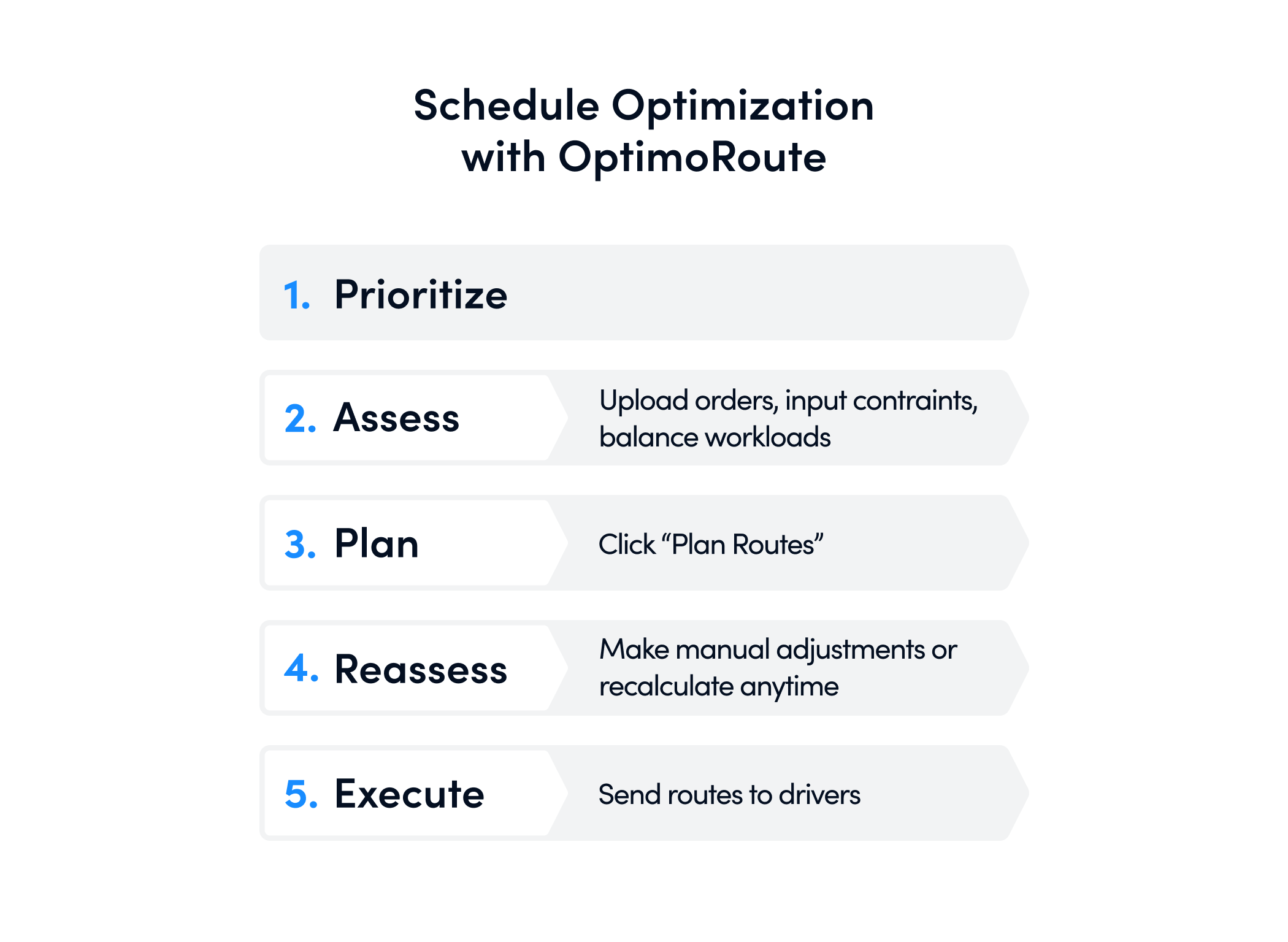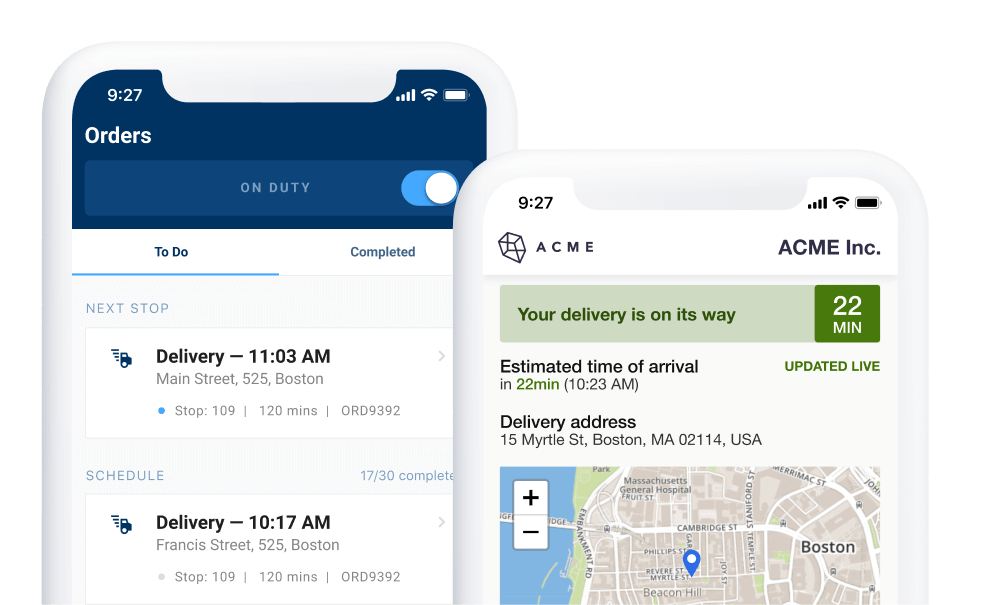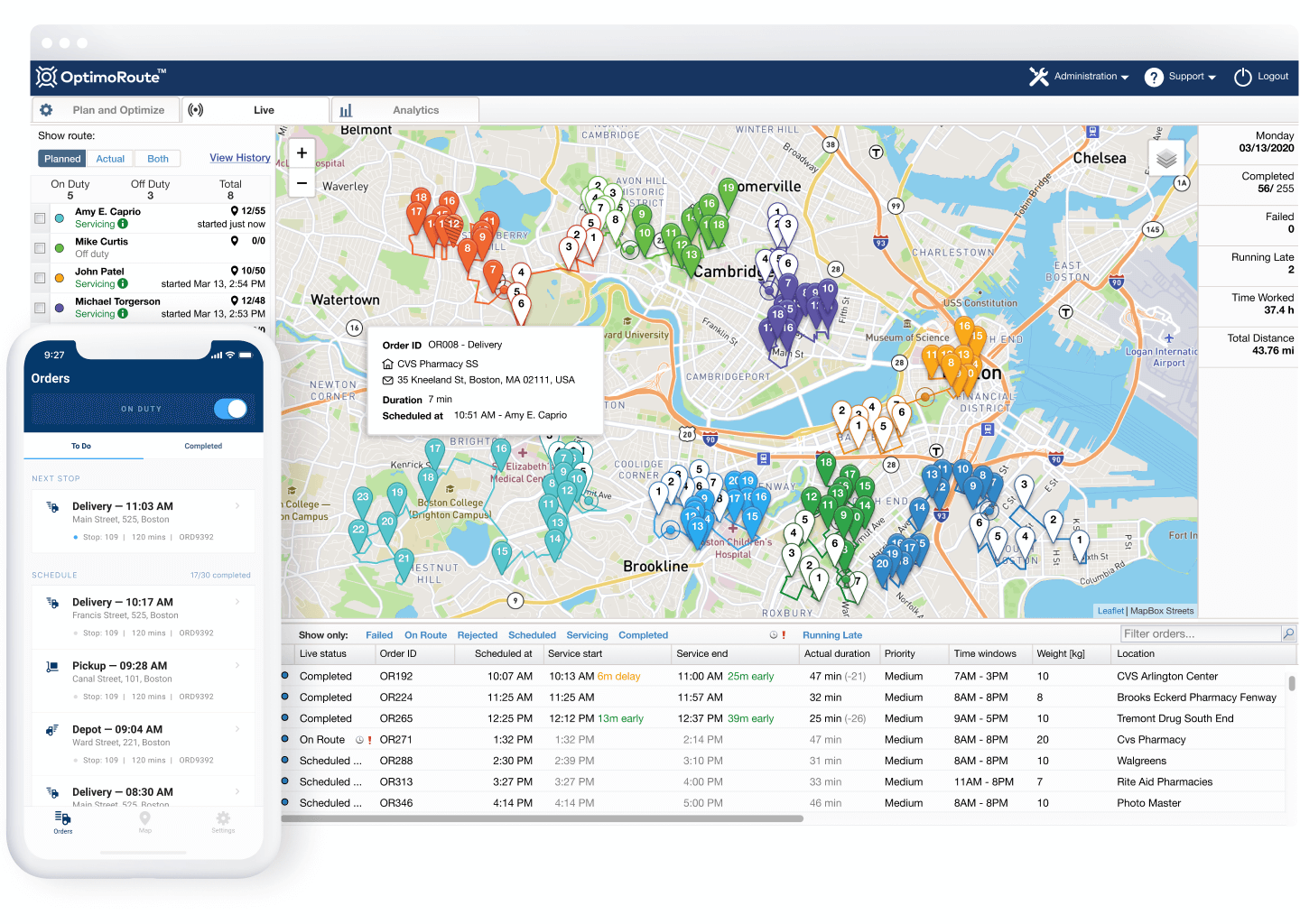Schedule Optimization: How to Optimize Schedules for Your Customers & Workers
9 min read

Schedule optimization is a win-win-win for businesses. Optimizing schedules can increase your company’s bottom line, create a better workload for your employees, and help you deliver a better customer experience.
In Schedule Optimization 101, we’ll explain precisely what schedule optimization is, why you need it, and how to achieve it in five simple steps. Then, we’ll show you examples of businesses that are using optimized schedules to their competitive advantage in vastly different industries.
What Is Schedule Optimization?
Schedule optimization is the process of making sure each individual task or action in a schedule is aligned with your ultimate goal. Schedule optimization can be used by individuals and businesses alike to keep their top priority (or priorities) at the forefront when setting times for tasks to take place.
Delivery companies often use schedule optimization to make sure a delivery route is laid out with the least possible mileage (and thus lowest fuel cost). Parents frequently use schedule optimization to make sure a child’s after school schedule prioritizes completing homework and/or getting to bed on time.
In our personal lives, we often optimize schedules without even realizing it, but in business, it takes a bit more effort to achieve truly optimized schedules. The good news is it’s easy to do once you understand how it works, and you can use technology to get it done faster. Whether you use a forward or backward scheduling strategy to create schedules for your business (or both) it’s important to make sure your schedules are optimized.
The Benefits of Scheduling Optimization
Businesses, customers, and employees can all benefit when a company optimizes schedules. You get to choose what a schedule is optimized for, so the possible benefits are practically limitless. These are some common benefits companies can expect from schedule optimization.
Increased revenue
If increasing your profit margin is your number-one goal (which is the case for many companies,) schedule optimization can help you across the board. Employee schedules can be optimized for the lowest cost and maximum output. For example, you could optimize delivery driver schedules for the least mileage, lowest number of overall hours to fulfill orders, and/or maximum capacity.
Supply chain managers can use schedule optimization to make sure they’re ordering just enough product to meet demand without having excess supplies taking up space in a warehouse. Schedule optimization can increase revenue by streamlining worker, logistics, and maintenance schedules.
Improvement of overall efficiency
At its core, the purpose of schedule optimization is to increase overall process efficiency. You can apply this to a delivery process, pickups, maintenance services, or any aspect of a business that involves completing tasks during specific timeslots. If your goal is to have each of your service professionals operating at maximum capacity, you can use schedule optimization to identify gaps where more tasks can be added, as well as schedule breaks to have the lowest impact on appointments.
Met or exceeded deadlines
Meeting (or exceeding) due dates or delivery windows is critical for a company’s success. If you want to achieve more on-time deliveries, schedule optimization is a great place to start. Truly optimized schedules take into account travel time, appointment or delivery duration for each individual order, stops for refueling, and every other piece of the scheduling puzzle. Put together, these pieces add up to getting products or services to your customers on time (and likely winning you repeat business).
Boosted productivity and employee morale
Smart companies use schedule optimization to benefit their employees, too. Balanced work schedules can reduce employee stress, burnout, and turnover, all of which add up to major costs for businesses.
The leading cause of work stress is workload, according to a survey of North American workers conducted by Statista. Couple this with the fact that 63% of American workers say they are so stressed at work they are considering quitting, and workload becomes a primary focus for companies looking to increase employee retention.
Optimizing employee and contractor schedules may look different depending on your business. You’ll need to consider what is important to your workers. Will they appreciate even workloads (this is often the case for couriers who get paid by the order), or will they appreciate more advance notice when it comes to shifts (see our guide on shift work scheduling for more on this)? If you’re not sure, you may want to actually sit down and ask your employees what challenges they are facing. You can use this information to inform how you optimize schedules going forward.
How to Optimize Your Schedule in 5 Steps
There are five essential steps to optimizing a schedule.

1. Identify your priority
Before you get into the nitty-gritty of reorganizing your schedule, it’s important to identify your main goal or goals. This could be as simple as cutting costs or delivering orders on time. The more specific and focused your goal is, the easier it will be to optimize your schedule.
2. Assess your to-do list
Look over your tasks (or orders) for the upcoming day, week, or month (however far out you want to schedule). Use these questions to identify high-priority tasks as well as constraints that will affect when/how a task can be scheduled.
- Will this task get me significantly closer to achieving my goal from step 1? If we think of a parent creating an after school schedule for their child, doing homework is likely to be the first thing scheduled. The reason for this is that getting good grades has the biggest impact on their child’s success and future potential (a big priority for parents). You want to look at your business scheduling the same way.
- Is this task urgent? An example of an urgent task would be a rush delivery where a client paid extra for a quick turnaround.
- Does this task have specific requirements that need to be factored in? A service request that requires a worker with a particular skillset is a good example.
- Can any of these tasks be grouped? For example, if you need to send a file to someone, it might make sense to schedule this task during a time when you can also check your email.
Once you’ve clarified any resource constraints, tasks that need urgent attention, and tasks that can be combined to save time, you’ll be able to find balance and optimize each part of your schedule.
3. Formulate your plan
In his book The 7 Habits of Highly Effective People, Stephen Covey wrote, “The key is not to prioritize what’s on your schedule, but to schedule your priorities.” When you’re putting your schedule together, the tasks that get you closer to achieving your priority from step 1 should go on the calendar first (just like the parent scheduling time to do homework first). After that, schedule urgent tasks. Finally, you can use open windows to fill in remaining lower-priority tasks.
4. Reassess your plan
As you get closer to the day and time when tasks are scheduled to be completed, you’ll need to reassess your plan. Orders (or their priority) may have changed, drivers may have requested time off, and many other circumstances may have impacted tasks. Advance planning will make it easier to adapt to these last-minute changes and help you spot windows where additional orders or tasks can be easily incorporated into an existing plan.
5. Knock out your schedule
Send your optimized schedules to employees and reap the benefits of an optimized workflow!
How to Optimize Your Schedule With OptimoRoute
At OptimoRoute, we help businesses with mobile workforces optimize delivery, pickup, sales, and/or service schedules. This includes businesses with remote sales teams, HVAC and pool maintenance professionals, and eCommerce businesses. Here’s a step-by-step breakdown of how you can use OptimoRoute to streamline the entire route optimization process.

1. Prioritize
Just a few of the priorities OptimoRoute can optimize for include:
- Increasing revenue
- Minimizing costs or reducing wasted spend
- Increasing efficiency
- Balancing driver workloads
- Saving time
2. Assess
To get started in OptimoRoute, upload your orders or service requests from a spreadsheet or document. You’ll be able to enter service constraints and specifications that can be saved for future planning.
You can control how delivery or service appointments are prioritized using the workload balancing feature. The sliding bar allows you to choose between routes that are optimized for the lowest cost (per contracted driver), evenly distributed workloads, or a blend of the two.

Reduce your operational costs by 30%
Increase delivery capacity by 43%
Plan 7x faster
3. Plan
Using OptimoRoute, you’ll get a complete schedule with the most efficient routes for up to five weeks with a simple click of a button.
4. Reassess
You can always make manual adjustments to planned delivery routes. Additionally, OptimoRoute helps fleet managers identify time windows and days when additional drivers are required to meet a rise in demand, as well as days when there isn’t enough work to keep scheduled drivers busy for a full shift.
5. Execute
Optimized routes and schedules can be sent directly to a mobile app on field workers’ phones. Need to make changes (or do another reassessment) after your driver is already en route? No problem. Dynamic replanning allows dispatchers to make changes at any time and see where their drivers are along a route with real-time tracking and breadcrumbs.

Examples of Schedule Optimization in 5 Different Industries
While the overall benefits carry over regardless of your business type, the specifics of schedule optimization vary from industry to industry. Here are a few examples of businesses that have used schedule optimization to achieve their goals.
1. Field/outside service
Telgian is an American life safety and fire protection company with consultants who travel to customers across large geographic areas. Telgian schedulers plan multi-day long-haul schedules for workers who spend up to a full week traveling to appointments. This kind of complex planning can be time-intensive, but they were able to optimize their schedules for revenue and lowest cost using OptimoRoute.
As a result, Telgian has boosted their scheduling efficiency by 82%. Scheduling now takes 66% less manpower, and they saw 19% year-over-year growth over a three-year span.
2. Repairs and maintenance
Southern Star supplies natural gas to Americans. They maintain approximately 5,800 miles of pipelines spread across the middle of the country. Prior to optimizing their schedules with OptimoRoute, Southern Star had difficulty finding time for low-priority tasks.
Using the right software to optimize schedules for efficiency, Southern Star increased their capacity by 100%. Even with their numerous order constraints and complex workflows, Southern Star is now able to accomplish even lower-priority tasks in the same amount of man-hours they had scheduled before optimizing.
3. Pharmaceutical
Innovative small businesses like Evolution Rx are using schedule optimization to deliver convenience to their customers. This independent pharmacy in Sugar Land, Texas, offers free prescription delivery to their customers and ensures maximum efficiency (and lowest cost) of their delivery routes using OptimoRoute.
4. Food delivery
With the food service industry’s notoriously low profit margins, restaurants and meal delivery businesses need to optimize delivery schedules for the lowest cost and maximum capacity if they want to survive. At OptimoRoute, we’ve helped countless food and beverage companies boost revenue by optimizing schedules and delivery routes.
Hardie’s Fresh Foods, a large food distribution company in Texas with a fleet of more than 150 refrigerated trucks, saw a 5% rise in on-time deliveries after they started using OptimoRoute. Additionally, their overall mileage decreased 20%, driver costs dropped 12%, and their capacity increased 14%.
Medvedgrad brewery in Zagreb, Croatia, optimized their delivery schedules for efficiency, which enabled them to adapt quickly in the face of COVID-19 related shutdowns. OptimoRoute helped them automatically calculate the most efficient delivery routes and ramp up quickly to fulfill more than 200 deliveries per day.
5. Collection and reverse logistics
Scheduling logistics is crucial for business, and optimizations are important for both forward and reverse logistics scheduling. CLEAResult is an energy consultancy that provides businesses, utilities, and consumers with efficient and renewable energy solutions. They operate an appliance recycling program in Michigan that is able to recycle up to 95% of the parts within used appliances.
CLEAResult picks up roughly 100 used appliances per day to be transported to a dismantling and recycling facility in Ohio. Using OptimoRoute, they were able to optimize these pickup routes for efficiency and minimize planning time. Two days of pickup schedules can be planned in just two hours.
OptimoRoute Does More Than Optimize Schedules
OptimoRoute not only streamlines the overall scheduling process and delivers all of the benefits we’ve discussed but sets you up for future success, too. Advanced analytics provides fleet managers with valuable insight that they can use to improve the scheduling and routing process going forward. Breadcrumbs show variations between planned routes and actual routes taken, which can serve as a knowledge base for recurring traffic and other obstacles along your drivers’ journeys.
Free schedule optimization for 30 Days
You can try OptimoRoute software and optimize your field service schedules for free for 30 days. Get started here.
Try OptimoRoute™ for Free
No installation or credit card required


